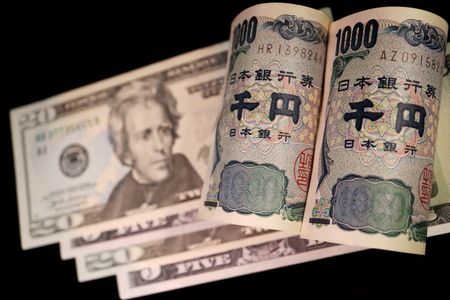By Karen Brettell and Harry Robertson
NEW YORK/LONDON (Reuters) -The yen dropped to its lowest level since 1990 on Wednesday before rebounding slightly after Japan’s top monetary officials met to discuss the rapidly weakening currency and suggested they were ready to intervene.
The dollar reached 151.975 yen, its strongest against the yen since mid-1990, before easing 0.13% on the day to 151.36.
The Bank of Japan, the Finance Ministry and Japan’s Financial Services Agency held a meeting in Tokyo’s late trading hours, after which top currency diplomat Masato Kanda said he “won’t rule out any steps to respond to disorderly FX moves.”
Japanese authorities stepped in to defend the yen at 151.94 in 2022 and Finance Minister Shunichi Suzuki on Wednesday used the same words that preceded that intervention, warning Japan would take “decisive steps” against excessive currency moves.
“They are swimming against the current here, to an extent.
Intervention helps in the near term, but it’s not a long-term solution,” said Bipan Rai, global head of forex strategy at CIBC Capital Markets in Toronto.
The yen has slumped more than 7% this year, driven by the widening gap between U.S.
and Japanese bond yields, which the Bank of Japan’s small interest rate hike last week did little to change.
The key to stemming the Japanese currency’s decline may now be the U.S. Federal Reserve beginning an interest rate cutting cycle and a decline in government bond yields outside Japan.
“I suspect that intervention, or threats to conduct intervention, are really just a measure of buying time until we start to see things shift on a more sustained basis outside the country,” Rai said.
Traders will also be focused on options expirations on Thursday in case they increase volatility in the currency pair.
About $3.13 billion in notional volumes struck around the 150-152 yen level are due to expire on Thursday, according to data compiled by Pepperstone market analyst Michael Brown.
“You may see some position covering on any intervention, which will naturally raise volumes and increase volatility.”
However, any options-related market move is likely to be fleeting, he added.
“The fundamental story remains the same in that sustained yen upside requires a move back in favor of the yen in terms of rate differentials which, unless the (Fed) is going to do some of the heavy lifting, seems unlikely,” Brown said.
KING DOLLAR
The dollar is on course for solid quarterly gains after investors pared back their expectations for big rate cuts in the face of strong economic data and reticence from central bankers.
Guy Miller, chief market strategist at Zurich Insurance group, said other currencies were suffering under the weight of a strong U.S.
currency.
“The U.S. economy has done much better than most had expected, particularly compared to other parts of the world,” Miller said.
The dollar index gained 0.05% at 104.34, and is up around 3% so far in 2024.
The market’s main focus this week is on U.S.
core inflation figures due on Good Friday, though a bigger-than-expected jump in U.S. durable goods orders on Tuesday already has boosted the dollar against the yen.
The euro fell 0.07% to $1.0821.
Sterling rose 0.06% to $1.263.
The dollar strengthened against Sweden’s crown after the Swedish central bank held interest rates and hinted at rate cuts in the coming months. It reached 10.64 crowns, the highest since Nov.
14.
The Swiss franc fell to its lowest since Nov. 3 at 0.9071 to the dollar. The Swiss currency is still reeling from a surprise rate cut in Switzerland last week, and is down around 7% this year.
In cryptocurrencies, bitcoin fell 1.78% to $68,567.00.
(Reporting by Karen Brettell in New York; Additional reporting by Saqib Iqbal Ahmed in New York, Harry Robertson in London, Tom Westbrook in Singapore and Dhara Ranasinghe; Editing by Sam Holmes, Lincoln Feast, Toby Chopra and Richard Chang)










